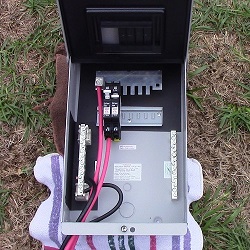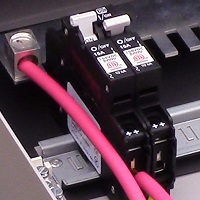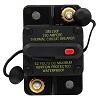
|
|||
|
Solar Accessories: Safety
In the previous articles in this series, we covered the essentials of selecting solar panels, batteries, chargers and inverters. Be sure to go back to the first article in this series for a complete overview of how to design an off-grid energy system. In this article, we cover cabling and connectors needed to make a complete and safer off-grid solar installation. Solar Safety
Most of the accessories listed in this section have been designed to make solar installations safer. One could field a solar system without them, but doing so is more risky than using these tools to do the job better. The most important thing to understand about solar installations is that the panels are always on, and even a broken panel can still be providing significant amounts of power. Plus, by definition, the panels are necessarily operating in a harsh environment outside, and so need to be protected against storms. Their cabling is often overlooked, and should be able to withstand the elements over a period of decades. Combiner
The first element of safety equipment is the combiner box. This item, shown to the right during a demonstration, resembles a circuit breaker panel, because that is exactly what it is. Each charger in your system will have one combiner dedicated to it. Each series string in your panel array will have one breaker dedicated to it. We recommend using a combiner box which has more available breaker slots than you think your design might require. For example, if your design calls for three strings, use a four- or six-breaker combiner. This gives you the flexibility of adding strings later if you want to optimize for hours-per-day rather than peak wattage. It is tempting to skip the combiner and rely on a series of MC4 or other PV-style Y-connectors to connect strings in parallel. Do not use Y-connectors as there is no combination in which you can safely connect panel strings of different voltages without risking internal arcing and damage. A damaged MC4 or other PV connector cannot handle the required currents and can lead to a fire. DC Circuit Breakers
Unlike a normal AC breaker panel as is in the home, the circuit breakers used in a combiner are special DC circuit breakers. Do not attempt to use an AC circuit breaker or circuit breaker panel in this application. In the photo to the left (click to enlarge), two circuit breakers are shown. As mentioned above, each panel string will have a circuit breaker dedicated to it. The circuit breaker rating will be higher than the maximum amperage rating of the panel. This is another difference between AC circuit breakers used in the home and DC circuit breakers used in a solar application. For example, a 9 amp panel string will typically use a 15 amp breaker. The solar panel manufacturer will usually recommend a breaker capacity for their panels. If not, then multiply the maximum short circuit rating of the panel by 1.44, then round up to the next available breaker size. In this example, 9 amps x 1.44 = 12.96 amps. The next available breaker size is in this case is 15 amps. Combiner breakers also fulfill the very important role of breaking the current to allow assembly or maintenance on panels. Never work on a panel string or make connections or disconnections while the breaker is on or without a breaker in the circuit. Not only would this be unsafe, the panel's connectors will be ruined by even one make- or break-contact in this way. If you hear a pop while connecting or disconnecting solar panel connectors, that connector pair has almost certainly been ruined by the arc. Cut them off and replace them. Finally, always make sure you are using the DC breakers and combiner boxes from the same manufacturer for the same combiner box product series. Never mix and match manufacturers or breakers in any combiner box. It is perfectly acceptable to have an assortment of manufacturers or series as long as each combiner unit is consistent. Surge Protection Devices
Surge protection devices are nodules which are usually designed to conveniently mount to the side of a combiner box, and are then wired internally to the critical bus bars. The purpose of these devices is to absorb surges from nearby lightning strikes. This protects all the downstream components from these surges. The surge protector will cost about as much as the combiner, but will save very expensive chargers, batteries, inverters, wiring and possibly your house and your life the first time it is needed. These devices usually have three wires. Red and black are wired to the PV positive and negative bus bars, while green is wired to the combiner box chassis ground, which itself is grounded to earth. Battery Breakers
Just as the combiner breakers isolate the panels from the combiner, the charger breaker isolates the charger from the batteries, and a second inverter breaker can be used to isolate the inverter from the batteries. Each of these breakers will be low voltage, high current devices. A typical model for use with a 24v battery array is shown to the left. This model is capable of 150 amps, which is perfect for a charger with a maximum current output under 100 amps, and an inverter with a maximum supply current of about 150 amps (around 3600 watts output). These items are generally used for automotive or marine applications, and as a result, are relatively inexpensive. Next article: Cables and Connectors ... |
Announcements
Amateur Radio Solutions Available Our development staff now includes Amateur Extra radio FCC licensees, increasing the breadth of our existing wireless development services. Posted: 12 Nov 2015 Details Here |
© 2001 - 2016 SoftBaugh, Inc. All rights reserved.



